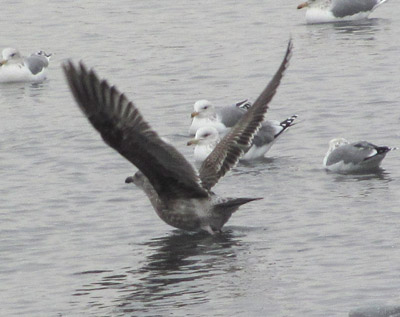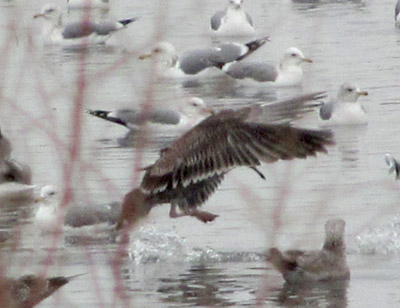Species: Western Gull (Larus occidentalis), 1 first winter
Reporter:
Cliff Weisse
4125 Beaver Springs Rd.
Island
Park, ID 83429
cliffandlisa@octobersetters.com
Other Observers: Lisa Weisse on Dec 27.
Date of
Observation: 27 December 2009 at Lee Kay Ponds and 5 January
2010 at Decker Lake
Date Report Prepared: 21 January 2010
Locality of Observation: Lee Kay Ponds near small patch of open water directly across the street from the landfill, and at Decker Lake.
Conditions:
On 27 December the observation took place late in the day with the
sun low in the sky from the side of and slightly behind the bird so
color discernment was marginal. Distance ranged from 100 yards to
about 50 yards. Duration of observation about 15 minutes.
On 5 January the observation took place at Decker Lake. I was standing at the culvert on the SW end of the lake and the sun was behind me making lighting conditions excellent. Duration of observation was on and off 1.5 hours (bird present entire time).
Binocualrs used were 10 x 42 Nikon Venturer LX and scope was Swarovski 80mm HD with 20-60x eyepiece. Camera used is Canon XS 120 IS and some photos were taken through the scope.
Description (prepared from photos and notes taken on 27 Dec):
First winter Larus as follows:
-Size
similar to Herring Gulls, obviously larger than California and
Lesser Black-backed Gulls in direct comparison.
-Overall cold dark brown coloration.
-Body slightly heavier/bulkier than Herring Gull, especially in the
rear so it appeared less attenuated than Herring. At all times the
secondaries were visible below the greater coverts and usually there
was a wide obvious blackish secondary skirt that contrasted sharply
with the upperwing coverts.
-Bill was solidly black all the way to the base with no pale
coloration seen. This was looked for at close range with 60x scope
and I could not see any pale
-Bill was proportionately thicker than Herring Gull with strong
gonys making the bill appear heavier at the tip.
-Head was brown with solid or smooth (unstreaked) brown surrounding
the eye. Malar region, nape, and lower face (below line of bill)
paler/streaked.
-Head rounded or domed above eye, not flattened as in Herring Gull,
with eye placed further back on head than Herring.
-Breast and fore neck were cold gray brown.
-Rear portion of belly and vent were paler appearing dirty cream
colored.
-Undertail coverts appeared pale overall but they were barred brown
and dirty white.
-Mantle appeared dark grayish brown and contrasted with paler/faded
upperwing coverts. Close examination revealed that scapulars
had wide blackish brown shaft streaks with paler brown edges.
-Upperwings coverts were faded to medium brown with paler buff
edges. Lesser and median coverts were solid brown with pale edge
and no internal markings or notching along edges. Greater coverts
solidly brown at base with outer half of inner feathers heavily
checkered with whitish. Outer greater coverts solidly brown to the
tip with narrow pale buff edges (there was also a gap in the greater
coverts on the right side of the bird that was seen on both days of
obvservation, perhaps created by a missing feather? There is also
possibly a missing secondary at the same location).
-Tertials solidly blackish brown with limited whitish tips and no
notching or barring.
-Primaries on folded wing solidly blackish with very narrow pale
tips. Primary extension medium (similar to Herring Gull) with three
primary tips visible beyond end of tail.
-Spread wing showed blackish primaries with only slight hint of pale
inner primary/outer secondary window created by narrow pale inner
edge of inner primaries. Rest of primaries blackish. Secondaries
blackish with wide white tips creating obvious white trailing edge
on inner wing. Overall appearance of upper wing was brown with
blackish primaries/secondaries. white trailing edge of inner wing,
and whitish stripe created by tips of greater coverts.
-Rump dirty whitish with dark brown bars on individual feather (bars
not extending all the way across the tract) creating overall pale
appearance and contrasting obviously with tail and mantle.
-Uppertail coverts barred brown and dirty white appearing darked
than rump.
-Tail completely blackish without pale bases to outer rectrices or
whitish notches along outer web of R6 but with narrow pale tips on
rectrices.
-Legs pink, darker than Herring Gulls in direct comparison but not
bright reddish pink as in Thayer's.
Behavior:
This individual was aggressive towards several first winter Herring
Gulls, chasing them around and once stealing food from one.
Otherwise it seemed to ignore other species. It was observed
loafing on the water, standing on the ice, and bathing/preening at
Decker Lake. At Lee Kay it was roosting for a while before being
recognized as a possible WEGU, then it was standing on the edge of
the ice before departing (presumably heading to roost). No calls
were heard.
Identification:
At first glance (while roosting at Lee Kay) this individual
appeared cold brown overall with unmarked coverts and dark mantle
suggesting Western Gull. When I later saw the heavy bill with
bulbous tip I thought it was at least part WEGU (a Western x
Glaucous-winged had been reported at this location a day or two
earlier) but lighting conditions were difficult and I couldn't be
sure of the ID. It wasn't until I again viewed this individual at
Decker Lake on 5 January (confirmed as the same bird by previously
observed field marks including missing greater covert on right side)
that I was sure of the identification. Lighting was excellent and
distance was fairly close so all field marks were easily
observed/confirmed including bill and head color and shape, wing and
tail color, leg color, pattern of coverts and scapulars, etc.
Elimination
of other species:
Only other black-winged gulls are contenders for
misidentification. Glaucous-winged is easily eliminated by the
blackish primaries as are Glaucous-winged x Western and Glaucous-winged
x Herring hybrids, all of which would show brown primaries, secondaries and tail
not the blackish shown by this bird. Thayer's can be quite dark
winged but not blackish and differs further by short narrow bill
with weak gonys, highly patterned coverts, heavy chested attenuated
body shape with legs set further forward under the bird, lack of
secondary skirt, pale base of tail, darker legs, and rounder head
with eye placed further forward. Other species are eliminated by:
-Great Black-backed Gull has white tail with
black terminal band; varibly streaked underparts that appear paler;
extensively checkered upperwing coverts that appear much whiter than
this individual; is much larger; and has a massive bill.
-Lesser Black-backed Gull is smaller; has a much narrower bill;
fairly extensive pale bases to outer rectrices; and very slender
body with long primariy extension.
-Kelp Gull has extensively whitish head underparts, and rump, and
does not normally show an obvious secondary skirt.
-Yellow-footed
Gull is much larger; has a massive bill; extensively white uppertail coverts and
rump; and extensively whitish head and breast.
-California Gull is smaller; has sharply two-toned bill; very
slender body with very long primary extension; long narrow bill with
parallel edges and weak gonys.
-Slaty-backed Gull is more similar but differs by having brown primaries and tail; less bulky bill with weaker gonys; tail with pale bases to outer rects; secondaries without obvious white tips; and dark coloration limited to outer webs of outer primaries (pattern similar to Thayer's) with obvious pale inner primary window very similar to Herring Gull on spread wing but with less extensive dark in outer primaries.
-Herring Gull can also be similar but differs by being more slender, especially in the rear; lacking a secondary skirt; lacking obvious white tips to secondaries; usually having more patterned coverts; long narrow bill with weaker gonys, never appearing as bulbous as this individual; typically showing fairly extensive pale flesh on base of bill; has scaled or barred scapulars but never shows stripes created by dark shaft streaks; paler pink legs; and flat crown with squared off fore- and hind-crown creating blocky or square head; eye set further forward on head.
Hybrids were considered but Western Gull is known to hybridize only with Glaucous-winged and, as described above, this individual does not show any signs of hybridization with GWGU. I was worried about the possibility of Western x Herring but their breeding ranges do not overlap and no hybrids between these species have been reported.
The combination of field marks shown by this bird are entirely consistent with Western Gull but not with any other species or hybrid.
I've been birding approximately 17 years and have studied gulls seriously for the past ten years in Idaho, NJ, and Utah. My experience with Western Gull is limited to one trip to California ten years ago and extensive study of one first winter individual at Pickles Butte Landfill in Canyon County, ID, IBRC # 10-B-04
I give my permission to post this report to a public area of the internet.
Photos from Decker Lake 5 January 2010
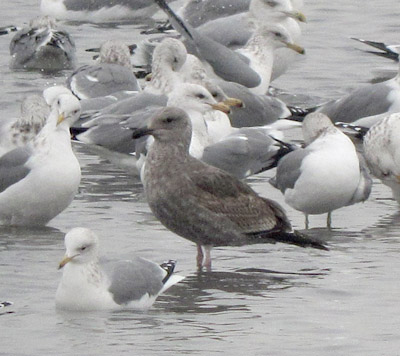
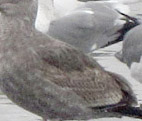
Cropped image lightened to show pattern of scapulars.
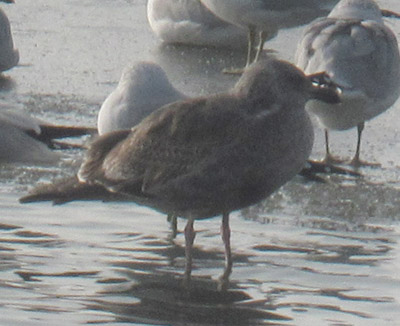
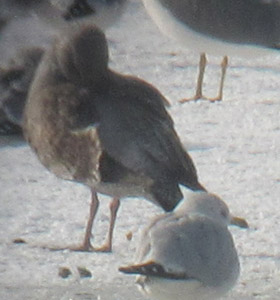
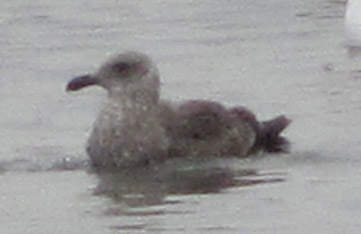
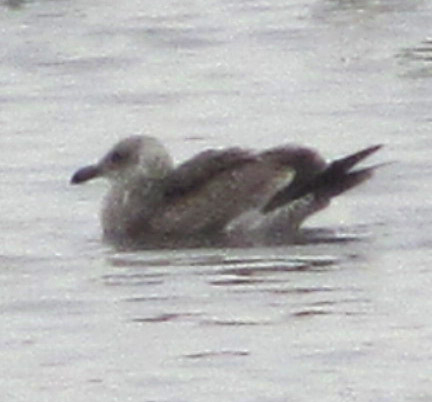
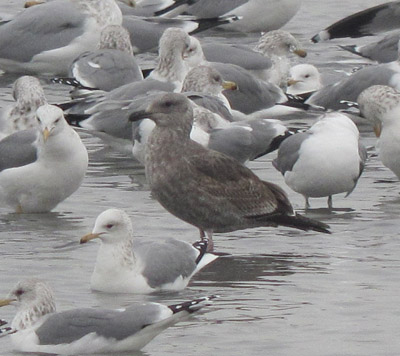
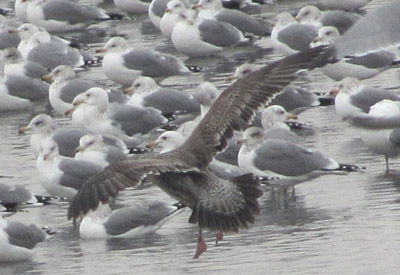
Below photos taken at Lee Kay Ponds on 27 December 2009
